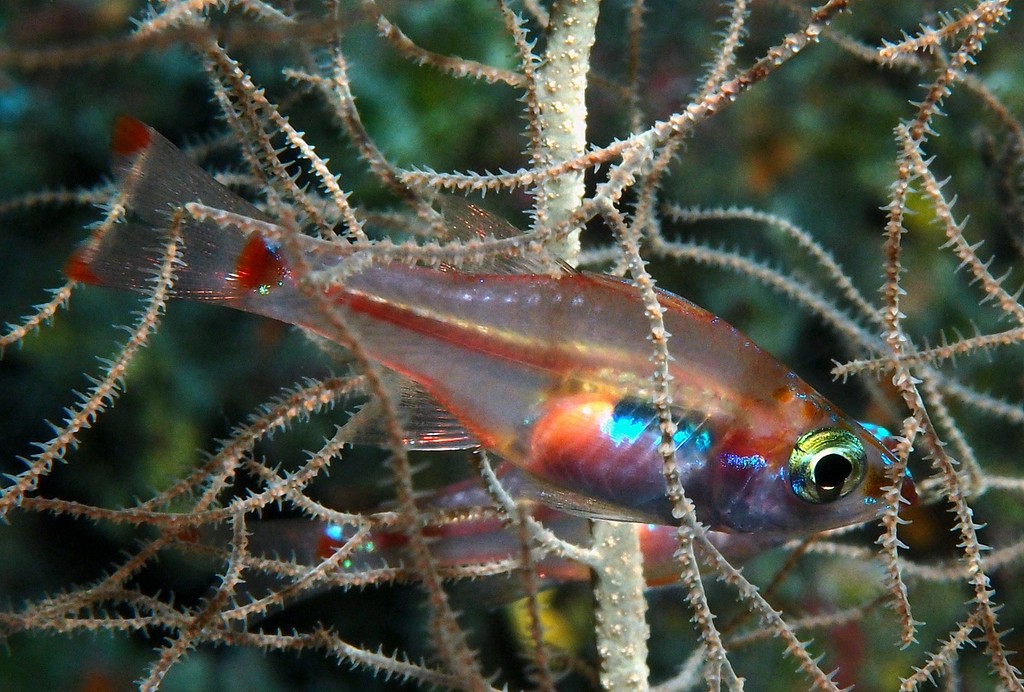OSTORHINCHUS DISPAR - (FRASER & RANDALL, 1976)
Actinopterygii (Gigaclass) > Actinopteri (Class) > Teleostei (Subclass) > Gobiiformes (Order) > Apogonoidei (Suborder) > Apogonidae (Family) > Apogoninae (Subfamily) > Ostorhinchus (Genus)
Poisson cardinal à points rouges, Redspot cardinalfish, White-spot cardinalfish, Whitespot cardinalfish, Kaburaya tenjiku dai, カブラヤテンジクダイ,
Synonyme
Apogon dispar (Fraser & Randall, 1976)
---------------------------
Description
Dorsal spines (total): 8; Dorsal soft rays (total): 8-9; Anal spines: 2; Anal soft rays: 8-9. Pectoral fin (both sides counted): 13-14; Pelvic fin: I +5; Principal caudal rays: 9 + 8; Secondary caudal rays: 6-10 above and 7-10 below; Well developed gillrakers: 21-25 (4-5 + 17-20), including rudiments: 23-26 (0-3 + 4-5; 17-20 + 0-1); Pored lateral line scales: 25; Transverse scale rows above lateral line: 2; Median predorsal scales: 4-5; Circumpeduncular scales: 12-13; Premaxilla with two rows of teeth anteriorly becoming a narrow band on the side; All teeth villiform with the outer teeth larger than those of the inner row. Dentary with two rows of teeth anteriorly becoming one row on the side, all villiform and about the same size; Vomer with one row of three small teeth on each side; None to three teeth on the palatine, no teeth on ectopterygoid or endopterygoid, occasionally teeth on base of basihyal. Max. length: 5.0 cm SL. Depth range: 18 - 58 m.
Color
Most of body translucent with orange-red and white markings; An orangered stripe extending from tip of lower jaw to anterior margin of eye, then continuing as a narrow post-ocular stripe, ending at base of caudal fin in a squarish spot; A small white spot above this orange-red spot; Two small reddish spots behind and slightly above eye; Caudal fin lobes broadly tipped with red; Cheek and abdomen silvery.
Poisson cardinal à points rouges, Redspot cardinalfish, White-spot cardinalfish, Whitespot cardinalfish, Kaburaya tenjiku dai, カブラヤテンジクダイ,
Synonyme
Apogon dispar (Fraser & Randall, 1976)
---------------------------
Description
Dorsal spines (total): 8; Dorsal soft rays (total): 8-9; Anal spines: 2; Anal soft rays: 8-9. Pectoral fin (both sides counted): 13-14; Pelvic fin: I +5; Principal caudal rays: 9 + 8; Secondary caudal rays: 6-10 above and 7-10 below; Well developed gillrakers: 21-25 (4-5 + 17-20), including rudiments: 23-26 (0-3 + 4-5; 17-20 + 0-1); Pored lateral line scales: 25; Transverse scale rows above lateral line: 2; Median predorsal scales: 4-5; Circumpeduncular scales: 12-13; Premaxilla with two rows of teeth anteriorly becoming a narrow band on the side; All teeth villiform with the outer teeth larger than those of the inner row. Dentary with two rows of teeth anteriorly becoming one row on the side, all villiform and about the same size; Vomer with one row of three small teeth on each side; None to three teeth on the palatine, no teeth on ectopterygoid or endopterygoid, occasionally teeth on base of basihyal. Max. length: 5.0 cm SL. Depth range: 18 - 58 m.
Color
Most of body translucent with orange-red and white markings; An orangered stripe extending from tip of lower jaw to anterior margin of eye, then continuing as a narrow post-ocular stripe, ending at base of caudal fin in a squarish spot; A small white spot above this orange-red spot; Two small reddish spots behind and slightly above eye; Caudal fin lobes broadly tipped with red; Cheek and abdomen silvery.
Etymology
Ostorhinchus: from Greek, osteon = bone + from Greek, rhynchos = beak. In reference to the bony jaws, very much advanced and jagged, which take the place of the teeth.
dispar: from Latin, dispar = unlike, dissimilar, different, unequal. The latin adjective dispar is used because of the unusual body shape and coloration of this Ostorhinchus.
Original description: Apogon dispar Fraser & Randall, 1976 - Type locality: Small cave at base of southwestern end of Augulpelu reef, Palau Island, western Caroline Islands, depth 36 meters, 13 April 1970, J. E. Randall.
Ostorhinchus: from Greek, osteon = bone + from Greek, rhynchos = beak. In reference to the bony jaws, very much advanced and jagged, which take the place of the teeth.
dispar: from Latin, dispar = unlike, dissimilar, different, unequal. The latin adjective dispar is used because of the unusual body shape and coloration of this Ostorhinchus.
Original description: Apogon dispar Fraser & Randall, 1976 - Type locality: Small cave at base of southwestern end of Augulpelu reef, Palau Island, western Caroline Islands, depth 36 meters, 13 April 1970, J. E. Randall.
Distribution
Indo-West Pacific: Cocos-Keeling Islands and Indonesia east to Palau and Fiji, north to Yaeyama Islands (Japan), south to Papua New Guinea, Solomon Islands and New Caledonia.
Biology
Found in caves of drop-offs; Also in clear coastal to outer reefs, commonly in large black corals growing away from walls. Forms aggregations. Mouthbrooders. Distinct pairing during courtship and spawning.
Similar species
Ostorhinchus melanoproctus (Fraser & Randall, 1976) - Reported from New Caledonia - Link to the species (here).
Indo-West Pacific: Cocos-Keeling Islands and Indonesia east to Palau and Fiji, north to Yaeyama Islands (Japan), south to Papua New Guinea, Solomon Islands and New Caledonia.
Biology
Found in caves of drop-offs; Also in clear coastal to outer reefs, commonly in large black corals growing away from walls. Forms aggregations. Mouthbrooders. Distinct pairing during courtship and spawning.
Similar species
Ostorhinchus melanoproctus (Fraser & Randall, 1976) - Reported from New Caledonia - Link to the species (here).
Last update: 22, September 2022
